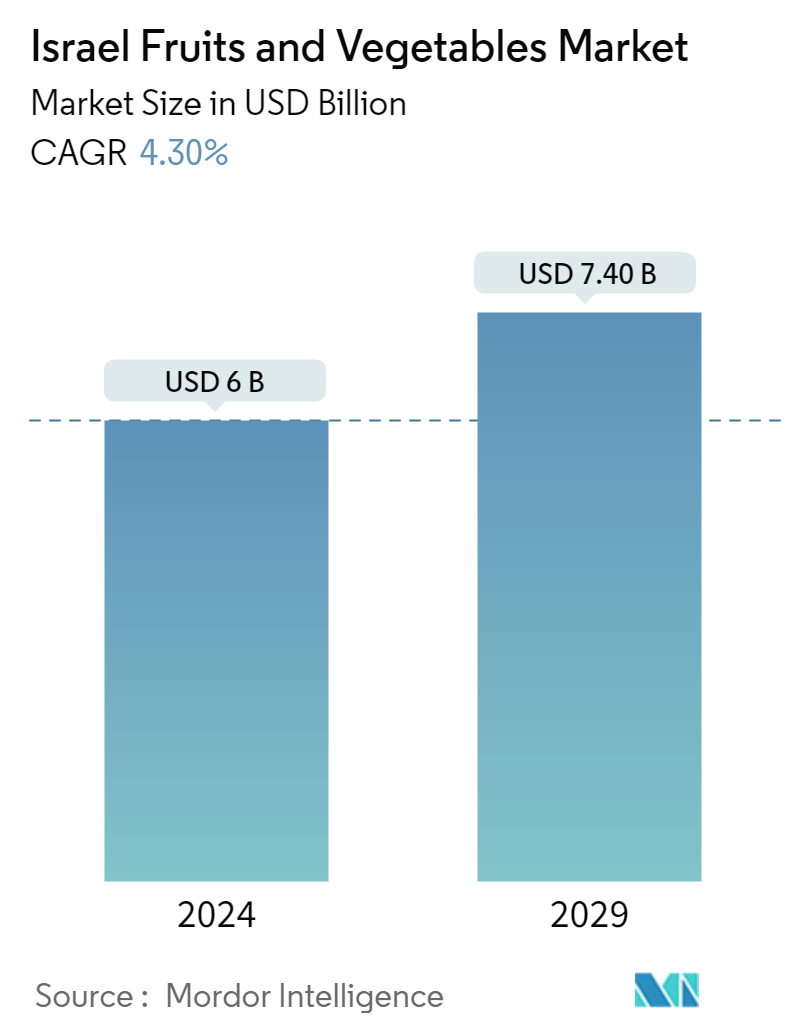Market Size of Israel Fruits & Vegetables Industry

| Study Period | 2019 - 2029 |
| Base Year For Estimation | 2023 |
| Forecast Data Period | 2024 - 2029 |
| Market Size (2024) | USD 6 Billion |
| Market Size (2029) | USD 7.40 Billion |
| CAGR (2024 - 2029) | 4.30 % |
Israel Fruits and Vegetables Market Analysis
The Israel Fruits & Vegetables Market size is estimated at USD 6 billion in 2024, and is expected to reach USD 7.40 billion by 2029, growing at a CAGR of 4.30% during the forecast period (2024-2029).
Israel's fruit and vegetable market, known for its technological advancements and efficiency, significantly shapes the nation's agricultural sector, even amidst challenges like water scarcity and climatic constraints. Urbanization and rising disposable incomes have spurred a growing demand for fruits and vegetables, as healthier dietary choices gain prominence. The Israeli diet boasts a variety of fruits and vegetables, from citrus fruits, mangoes, and avocados to grapes, pomegranates, tomatoes, and carrots. Leading the charge in agricultural innovations, Israel employs advanced irrigation methods, greenhouse cultivation, and growth house techniques. Highlighting this trend, Northern Israeli startup MetoMotion unveiled its Greenhouse Robotic Worker (GRoW) in August 2022. This groundbreaking technology, designed for tomato harvesting in greenhouses, boasts AI-driven 3D stereo vision for fruit identification, a specialized tool for damage-free harvesting, and advanced analytical software. Such innovations not only tackle labor shortages in agriculture but also promote sustainable farming, driving market growth. Furthermore, Israel is a key exporter of fruits and vegetables, targeting European nations and the US Data from the ITC Trade Map reveals that in 2023, potatoes topped the export list, with 155,496 metric tons fetching a value of USD 88.56 million. To bolster innovation and self-reliance in the industry, the Israeli government extends financial support to the fruits and vegetables sector through various means. A notable instance is the USD 50 million loan allocation in 2022, aimed at assisting farmers of export-centric crops like avocados, almonds, and citrus fruits during economically challenging times.
Israel Fruits and Vegetables Industry Segmentation
Fruits and vegetables are important supplements to the human diet as they provide the essential nutrients for maintaining health.
The Israel fruits and vegetable market is segmented into fruits and vegetables. The report offers an analysis of production (volume), consumption (value and volume), import (value and volume), export (value and volume), and prices. The report offers the market size and forecast in both value (USD) and volume (metric tons).
| Vegetables | |
| Production (Volume) | |
| Consumption (Value and Volume) | |
| Import (Value and Volume) | |
| Export (Value and Volume) |
| Fruits | |
| Production (Volume) | |
| Consumption (Value and Volume) | |
| Import (Value and Volume) | |
| Export (Value and Volume) |
Israel Fruits & Vegetables Market Size Summary
The Israel fruits and vegetables market is experiencing a robust growth trajectory, driven by a combination of local production and strategic agricultural innovations. The majority of the produce consumed in Israel is grown domestically, with only a limited amount imported, fostering healthy competition and contributing to a lower cost of living. This self-sufficiency is bolstered by government support in the form of budgets, grants, and investments aimed at enhancing the technological and innovative capabilities of Israeli agriculture. The country's commitment to achieving near-complete self-sufficiency in fruit consumption by the end of the decade is a significant driver of market expansion. The fruit and vegetable sectors are extensively cultivated across various regions, with citrus and orchards being predominant in the fruit industry, while the vegetable sector benefits from diverse cultivation methods, ensuring year-round production.
The market's growth is further supported by the increasing demand for fresh produce, which is rich in essential nutrients and plays a crucial role in maintaining public health. Israeli growers supply a substantial volume of fresh fruits and vegetables to the local market, aligning with dietary recommendations that emphasize a high intake of plant-based foods. The Mediterranean dietary plan adopted in Israel complements this trend, promoting the consumption of unprocessed, whole foods. The country's focus on maintaining food security and reducing dependency on imports is evident in its stringent import regulations, particularly concerning citrus fruits, to prevent the introduction of pests and diseases. Additionally, Israel's citrus industry is expanding its export reach, with significant markets in Asia and Europe, further solidifying its position in the global market. Innovations in post-harvest technology, such as the use of artificial intelligence to extend the shelf life of produce, are also contributing to the market's growth by reducing waste and enhancing the quality of exported goods.
Israel Fruits & Vegetables Market Size - Table of Contents
-
1. MARKET DYNAMICS
-
1.1 Market Overview
-
1.2 Market Drivers
-
1.2.1 Technological Advancements in Farming
-
1.2.2 Favorable Trade Agreements and Liberalization
-
-
1.3 Market Restraints
-
1.3.1 Price Volatility of Fruits and Vegetables
-
1.3.2 International Conflicts and Climatic Uncertainties
-
-
-
2. MARKET SEGMENTATION
-
2.1 Vegetables
-
2.1.1 Production (Volume)
-
2.1.2 Consumption (Value and Volume)
-
2.1.3 Import (Value and Volume)
-
2.1.4 Export (Value and Volume)
-
-
2.2 Fruits
-
2.2.1 Production (Volume)
-
2.2.2 Consumption (Value and Volume)
-
2.2.3 Import (Value and Volume)
-
2.2.4 Export (Value and Volume)
-
-
Israel Fruits & Vegetables Market Size FAQs
How big is the Israel Fruits & Vegetables Market?
The Israel Fruits & Vegetables Market size is expected to reach USD 6 billion in 2024 and grow at a CAGR of 4.30% to reach USD 7.40 billion by 2029.
What is the current Israel Fruits & Vegetables Market size?
In 2024, the Israel Fruits & Vegetables Market size is expected to reach USD 6 billion.

